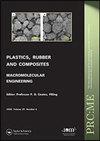通过大面积挤压沉积增材制造制备的聚合物复合材料的数值模拟:纤维取向、材料不均匀性和材料加载过程中的热力学响应
IF 1.2
4区 材料科学
Q3 MATERIALS SCIENCE, COMPOSITES
引用次数: 0
摘要
在聚合物挤压过程中形成的流动诱导纤维取向导致复合材料在大面积挤压沉积增材制造(LAAM)过程中表现出非均匀的热力学行为。本文对LAAM法制备的20wt %短碳纤维增强聚乙烯亚胺的纤维取向状态进行了数值评价。采用完全耦合的流动/取向模拟方法确定了凝固后沉积头的纤维取向状态。沉积的复合材料的材料性能是通过假设沉积的头具有不同的局部纤维取向状态的非均匀区域来计算的。采用预测的非均匀材料特性,对薄壁结构的LAAM过程进行了有限元模拟。计算结果表明,采用均匀性质的模拟结果与采用非均匀性质的模拟结果存在显著差异。在非均质假设下计算的头部方向拉伸应力轮廓与文献中的实验数据相当,支持我们的数值方法。本文章由计算机程序翻译,如有差异,请以英文原文为准。
Numerical modelling on polymer composites prepared via large area extrusion-deposition additive manufacturing: fibre orientation, material inhomogeneity, and thermal-mechanical responses during material loading process
ABSTRACT The flow-induced fibre orientation formed during polymer extrusions causes the composite to exhibit non-homogeneous thermal-mechanical behaviours during Large Area extrusion-deposition Additive Manufacturing (LAAM) processes. This study numerically evaluates the fibre orientation state of a 20 wt.% short carbon fibre reinforced polyethylenimine fabricated by LAAM. The fibre orientation state of the solidified deposited bead is determined by a fully coupled flow/orientation simulation approach. The material properties of deposited composites are computed by assuming that the deposited bead has heterogeneous regions with varying local fibre orientation states. A finite element simulation is performed to model the LAAM process of a thin-wall structure, where the predicted inhomogeneous material properties are employed. Computed results show notable differences between simulations performed by employing homogenous properties and those obtained using heterogeneous properties. The bead-direction tensile stress contours computed under the heterogeneous assumption are comparable to experimental data in the literature, supporting our numerical approach.
求助全文
通过发布文献求助,成功后即可免费获取论文全文。
去求助
来源期刊

Plastics, Rubber and Composites
工程技术-材料科学:复合
CiteScore
4.10
自引率
0.00%
发文量
24
审稿时长
4 months
期刊介绍:
Plastics, Rubber and Composites: Macromolecular Engineering provides an international forum for the publication of original, peer-reviewed research on the macromolecular engineering of polymeric and related materials and polymer matrix composites. Modern polymer processing is increasingly focused on macromolecular engineering: the manipulation of structure at the molecular scale to control properties and fitness for purpose of the final component. Intimately linked to this are the objectives of predicting properties in the context of an optimised design and of establishing robust processing routes and process control systems allowing the desired properties to be achieved reliably.
 求助内容:
求助内容: 应助结果提醒方式:
应助结果提醒方式:


